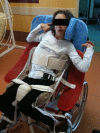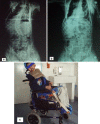Importance of hip problems in daily activities for cerebral palsy patients
- PMID: 24432102
- PMCID: PMC3838522
- DOI: 10.1007/s11832-013-0514-7
Importance of hip problems in daily activities for cerebral palsy patients
Figures





Similar articles
-
Soft-tissue release for hip subluxation and dislocation in cerebral palsy.J Rural Med. 2017 Nov;12(2):120-125. doi: 10.2185/jrm.2939. Epub 2017 Nov 30. J Rural Med. 2017. PMID: 29255529 Free PMC article.
-
Daily care activities and hip pain in non-ambulatory children and young adults with cerebral palsy.J Pediatr Rehabil Med. 2011;4(3):219-23. doi: 10.3233/PRM-2011-0177. J Pediatr Rehabil Med. 2011. PMID: 22207098
-
Cerebral Palsy: Hip Surveillance.Pediatr Ann. 2022 Sep;51(9):e353-e356. doi: 10.3928/19382359-20220706-06. Epub 2022 Sep 1. Pediatr Ann. 2022. PMID: 36098607
-
Hip problems in cerebral palsy: screening, diagnosis and treatment.Curr Opin Pediatr. 2014 Feb;26(1):85-92. doi: 10.1097/MOP.0000000000000040. Curr Opin Pediatr. 2014. PMID: 24299910 Review.
-
Pathologic hip morphology in cerebral palsy and Down syndrome.J Pediatr Orthop. 2013 Jul-Aug;33 Suppl 1:S29-32. doi: 10.1097/BPO.0b013e3182860034. J Pediatr Orthop. 2013. PMID: 23764790 Review.
Cited by
-
Cerebral palsy with dislocated hip and scoliosis: what to deal with first?J Child Orthop. 2020 Feb 1;14(1):24-29. doi: 10.1302/1863-2548.14.190099. J Child Orthop. 2020. PMID: 32165978 Free PMC article. Review.
References
Publication types
LinkOut - more resources
Full Text Sources
Other Literature Sources

